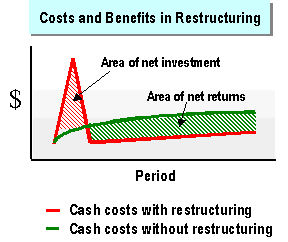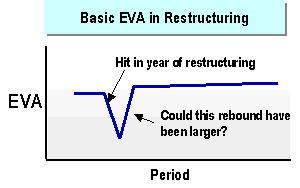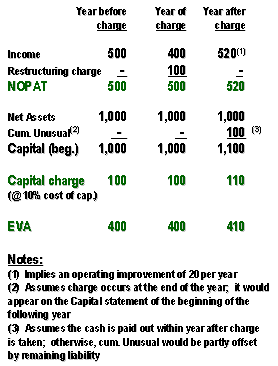Restructuring
Restructuring
denotes major changes to an organization such as plant closings, sale of
discontinuation of product lines, employee layoffs, or asset write-offs.
Such charges are generally broken out on the income statement as
extraordinary charges if they are significant. Otherwise, they would be
included in ordinary income as unusual or non-recurring charges.
GAAP requires the immediate write off of all restructuring charges. Plant closings and costs associated with lay-offs are considered deadweight losses to a companys financial position at the time they are announced. Asset write offs are considered "catch up" costs for prior year under-depreciation of the affected assets.
Economics of Restructuring
The decision to restructure a business is typically viewed as a long-term benefit for the company as it seeks to improve its competitive position to increase sales or reduce costs through operating efficiencies.
Restructuring
costs may be incurred over an extended period up to a couple of years.
 Restructuring benefits may materialize over many years or into the
indefinite future.
Restructuring benefits may materialize over many years or into the
indefinite future.
The market often looks favorably upon the announcement of restructuring with the anticipation that its announced charges will be outweighed by the value of its benefits. In many cases, the charges associated with restructuring reflect inefficiencies or asset impairments that have already been discounted from the firms value.
Far from being sudden realization of a dead-weight loss, restructuring charges should be viewed as investments in the improvement of the business. Expensing such charges mismatches the cost and benefits of restructuring.
Behavioral Impact
Since restructuring charges appear more quickly than their benefits, several perverse behaviors can arise when treating these charges as current costs.
The Thousand Needles
Management may be discouraged from aggressively pursuing restructuring opportunities in order to avoid incurring their current cost. Ignoring or delaying such opportunities can lose the company major ongoing cost reductions or new sales. Management will particularly avoid minor restructuring whose charges were likely to not be treated specially on the income statement. Such charges would simply depress income, often significantly, while the ongoing benefits appear later, often beyond their tenure.
Thus, while all the little things that should be changed or discontinued are allowed to continue, the business suffers a slow demise, a "death by a thousand needles," until the Big Bath.
The Big Bath
When management finally takes the painful step of restructuring, it usually decides to
"go big." A big charge will be segregated on the income
statement. The charge will be to take care of significant problems that
investors have likely already discounted. Whether the charge to take
care of those problems is $125 million or $140 million may be
considered, by management, an imperceptible difference to the outside
world.
Internally, the ability to reserve an extra million dollars here and half million there looks like a boon to divisional managers. Suddenly, all the little changes that should have been made before are now added to the big reserves. Furthermore, any "extra" amounts that could be related to restructuring can be easily buried in the charge.
When the year is over and the charge is announced and recorded, it is flushed away without a trace on the balance sheet.
The Big Rebound
Finally, while the year of restructuring is a good time to spend money, the year after isnt so bad either. Baseline EP/EVA may suffer an awful drop inherent in allowing a restructuring charge to affect NOPAT. But the following year would see a huge gain in Baseline EP/eVA with the NOPAT reversion to long-term operating profitability. A small part of this rebound may result from the changes brought about by the restructuring. However, most of it is due simply because the non-recurring charge does not, in fact, recur. This spike in Basic EVA can cover a lot of sins in the new year.
Alternative Treatment
Capitalizing the charge
We can add back restructuring charges to income and capitalize it, i.e.. add it, after-tax, onto net assets. This would require establishing an account for cumulative unusual items in which to track such capitalized charges into the future. This capitalized charge typically remains in the account forever, being added to or offset by other similar future charges, including gains on disposition.


For charges where the benefits may not be permanent, e.g., improved efficiency in a plant due to close in eight years, you may choose to amortize the charge over the life of the benefit. Any charge that gets amortized, however, must be segregated into its own account and a separate schedule established to for the amortization.
This treatment overcomes the perverse incentives noted above. By capitalizing the charge, capital would jump only by the difference between the capitalized restructuring charge and the associated liability created by it. As the liability declines (i.e., the cash goes out the door) capital would rise.
If the benefits of restructuring materialize in this time as well, EP should actually rise. However, if management has spent too much on the restructuring, then EP can fall as the capital charges grow to exceed the improvement in profitability.